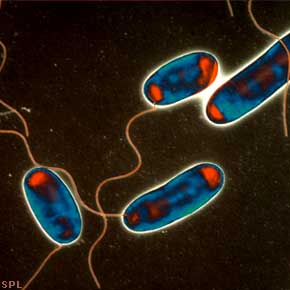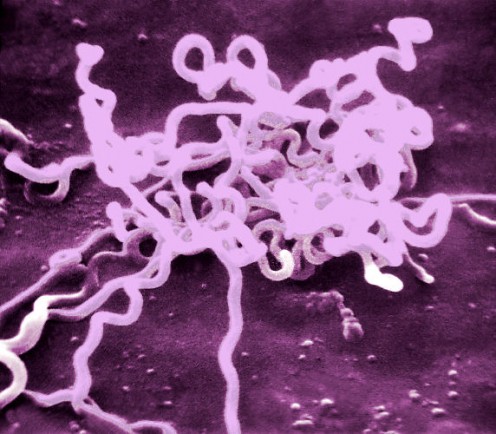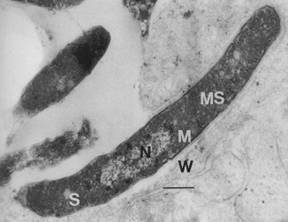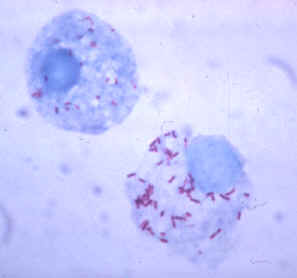Diseases Caused by Bacteria: Havoc and History
It is believed that bacteria have been present on earth for 3.5 billion years. While bacteria are essential to life on earth, there are some forms of bacteria that wreak havoc on the human body and often lead to disfigurement and death. Many of these diseases have an interesting history, often the cause of wide-spread panic and quarantine until the disease was understood and/or curable.
Most bacteria come in three shapes: coccus, or spherical; bacillus, or rod-shaped; spirillum, or spiral. Many bacteria live alone but can also live in clusters. The bacteria are named based upon the appearance of the cells: diplo are sets of two; strepto are bacteria in chains; staphylo appear in grape-like clusters.
While there are dozens and dozens of bacterial diseases, listed below are only four that I find interesting.
KNIT-FRIENDLY BACTERIA

Legionnaires’ Disease
In July of 1976, over 10,000 war veterans belonging to the American Legion held a convention in Philadelphia. By August, 14 men succumbed to high fevers, pneumonia-like symptoms and died. Numerous others who attended the convention were hospitalized and struggled for their lives.
President Ford prepared his administration to vaccinate citizens against swine flu and impose quarantines. It took six months to determine the illness was due to a bacterium, Legionella pneumophilia (named after the people suffering the disease), that was found in the hotel’s air conditioning system.
Legionella pneumophilia

Now known as Legionnaires ’ disease and treated with antibiotics, between 8,000-18,000 people are hospitalized every year due to the illness.
The bacterium grows best in warm water and is commonly found in large air conditioning systems, shower heads, hot tubs, hot water tanks, and large plumbing systems and is not spread from person to person.
Symptoms usually begin 2-14 days after exposure and are similar to pneumonia: high fever; chills; cough; muscle aches. Chest x-rays, sputum cultures, and tests on blood and urine are able to detect the bacteria in the body. Legionnaires’ disease has a 5%-30% fatality rate.
Treponema pallidum

Syphilis
It is believed that 20% of insane asylum patients in the 19th century suffered from syphilis, a sexually transmitted disease.
Syphilis, in the final stage, causes a condition known as General Paralysis of the Insane (GPI). Though the initial sign of GPI is depression, it slowly progresses to memory and intellectual impairment, grandiose delusions, over-excitability, and extreme personality changes. GPI also causes physical changes—slurred speech, tremors of the lips and tongue, pupils that don’t react to light, and inability to control muscles or difficulty with muscle coordination.
Syphilis is caused by the bacterium Treponema pallidum and has four stages. It is transmitted through sexual contact and from an infected mother to her baby during pregnancy.
Primary Stage: The first symptoms appear 10-90 days after a person has had direct contact with a lesion or sore, also called a chancre. The sore(s) can be visible on the external genitals and around the lips and mouth but may be hidden inside the vagina and/or the rectum. The sores will resolve without treatment.
Secondary Stage: A rash without an itch appear on the bottoms of the feet and the palms of the hands approximately 6-8 weeks after sore(s) disappear. People will often suffer from fatigue, fever, sore throat, weight loss, patchy hair loss, headaches and muscle aches in this stage of syphilis.
Third Stage: Also known as the latency period because the symptoms are hidden, this stage can begin anywhere from 2 to 30 years after the initial infection. Because this stage can last for so many years, people often do not enter the fourth and final stage of syphilis and die, instead, from some other cause of death. The bacteria are still present in the body during this stage and are beginning to attack major organs and tissues in the body.
Fourth Stage or Tertiary Stage: The bacterium begins to eat away at bones, vital organs of the body including the brain (causing GPI) and the central nervous system, and causes gradual blindness. Lesions may be present inside and outside the body. This stage of syphilis is what caused people to be admitted into insane asylums in the 19th century.
Diagnosing syphilis is simple and inexpensive via a blood test or analyzing tissue from a sore.
If someone has suffered from syphilis less than a year, one injection of Penicillin will cure it; however, syphilis that has been present longer than one year requires additional injections. Any damage to tissues, organs, and bone is irreversible.
All states in the US required a syphilis test prior to issuing a marriage license, but most states have eliminated this requirement. Possibly due to the elimination of syphilis testing, there seems to be an increase in the number of syphilis cases in the United States. In 2001 there were 32,284 documented cases, and in 2008 there were 46,277 cases.
Syphilis in the News
Mycobacterium leprae

Leprosy or Hansen's Disease
The first documented case of leprosy was in 600 BC. Caused by the bacterium Mycobacterium leprae, leprosy is a chronic bacterial infection characterized by lesions and nodules appearing on the body. Leprosy is diagnosed by analyzing material from the lesions.
Throughout history, people suffering from leprosy were ostracized and forced to live in leper camps. Presently, there are only about 100 cases of leprosy per year in the United States, although leprosy is still prevalent in parts of Asia and Africa, where leper camps still exist.
Despite the existence of leper camps, leprosy is not highly contagious and is transmitted through direct contact with drops from the nose, mouth, or eyes of someone with leprosy who is not undergoing treatment. Symptoms can take 4-8 years to appear after exposure, and children are more susceptible to leprosy than adults.
Treatment, developed in the early 1960s, consists of multi-drug therapy and can last for as little as six months or as long as three years. If left untreated, leprosy can cause severe nerve damage to the hands and feet, rendering limbs useless.
Life as a Leper
Leprosy in Tanzania
- An Inside Look at Global Health Activity at USC: Perceived Stigma of Leprosy Patients in Rural Tanza
The leprosy patients had suffered a great deal throughout their illness. Most were stigmatized because of the visible patches that appeared on their body. Some were kicked out of their homes, lost their friends, and discarded by society.
Rickettsia rickettsii

Rocky Mountain Spotted Fever
Named after the region where the disease was first discovered in 1896, Rocky Mountain Spotted Fever is caused by the bacterium Rickettsia rickettsii and is the most severe tick-borne illness in the United States. It is a seasonal disease, occurring in April through September.
The incubation period is 5-10 days. The initial symptoms include, fever, nausea, vomiting, muscle pain, and headaches. Later symptoms include abdominal pain, a rash that may not be present on everyone infected, joint pain and diarrhea.
Diagnosis is determined by clinical signs and lab work, and treatment is a tetracycline antibiotic. It is essential that treatment begin in the first week in order to avoid lasting effects of the disease. Most people suffering from this disease are hospitalized. Prior to the discovery of the antibiotic in the late 1940s, the fatality rate was 30% and is currently around 3%-5%.
The bacteria travel through the bloodstream and attack joints, kidneys, heart, lungs and the nervous system. If left untreated or undetected, complications include spinal meningitis, heart and kidney failure, blood clotting, and gangrene.
It is believed once you are infected with Rocky Mountain Spotted Fever that it provides lifetime immunity.












